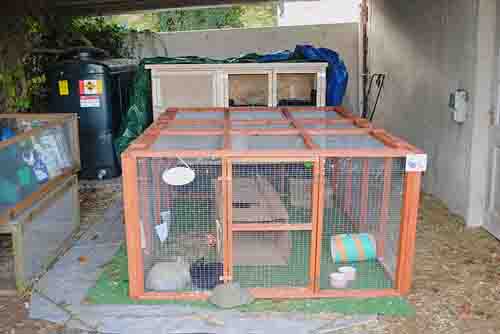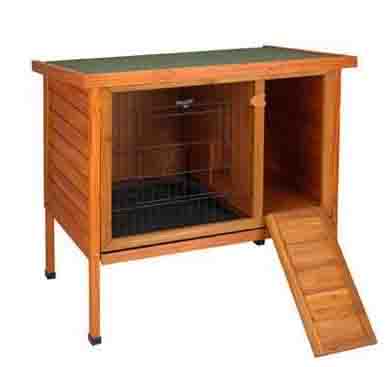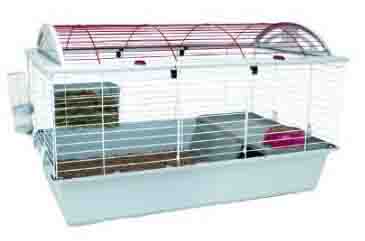Rabbits and the surge in demand for rabbit cages are due to the popularity of the pets in the United States for quite a few years now. Rabbit care and husbandry has evolved greatly in that time. If you are considering adopting a pet rabbit, you are probably wondering what type of enclosure to keep him in. Most of us have seen the outdoor wire rabbit hutches that were popular at one time. We now know that those types of enclosures are unhealthy and unkind, and today’s rabbit owners are much better about providing a comfortable and safe environment for their pet rabbits.
If you have children or dogs, it is best to keep them separated from your rabbit. Children have an affinity for rabbits because they are soft and cute, but they are also fairly fragile. If handled inappropriately or scared, they can severely injure themselves very easily. Similarly, many dogs have an innate urge to chase rabbits, and rabbits are usually terrified of most dogs. Cats and rabbits, however, tend to coexist peacefully within a household.
Rule of Thumb For Rabbit Cage Size
The size of a rabbit hutch depends on the number of rabbits kept and the amount of time you plan on keeping the rabbit in the enclosure. The rule of thumb is that a rabbit cage is 4x the length of the rabbit when stretched out as a full grown adult. The height of any rabbit enclosure should be allow the rabbit to be on its hind legs without the ears touching the top of the cage.
 Typical Rabbit Cage Hutch and Run on
Outdoor Patio
Typical Rabbit Cage Hutch and Run on
Outdoor PatioOutdoor Rabbit Cages Or Hutches
First of all, your rabbit should be housed indoors. Outdoor enclosures are not always appropriate for pet rabbits for many reasons. Pet rabbits housed outdoors are susceptible to predators. Even if they are ‘safe’ inside their cage, being trapped and immobile with a predator nearby can put enough stress on the rabbit to actually cause medical problems, such as cardiac events. Outdoor rabbits are also susceptible to the elements and parasites that are found outdoors. Indoor rabbits are much healthier and safer, and will be more engaged with and bonded to their owners.
There are two basic types of types of rabbit enclosures. Many are too small, so many owners opt to build their own (see plans below). Each type is discussed below:
- Wooden Rabbit Hutches: These have a natural look and can be painted on the outside to match the taste of the owner. The downside is that rabbits like to gnaw on wood and can be harder to clean and disinfect. Wood can also absorb urine and water. If you want to use wood, consider using wood for the outside of the rabbit enclosure and wire for the inside. Do not use treated pine wood to avoid exposing the rabbit to toxic chemicals.
- Welded Wire Rabbit Cages: Wire rabbit cages usually vary in construction, particularly the base. This is because the most time consuming part of owning rabbits is cleaning the cage. The lower plastic base either has a plastic tray or mesh covered tray. Some have multiple levels to provide the rabbit with more ways to exercise and feel at home. A wire mesh floor can harm the rabbit with sores, so be sure to cover it with some type of bedding (shredded paper, straw). Welded wire is more durable than wooden rabbit hutches.
If you do house your rabbit outdoors, make sure they have a place that can protect them from predators and from the weather. Many stores that sell rabbits also offer outdoor rabbit hutches that come pre-assembled or you can make a rabbit hutch yourself. Any cage must have enough height to enable the rabbit to sit up and stand. The hutch should be part of a run surrounded by a rabbit fence that will keep the rabbit in and any threats to the animal out. The run also needs to provide ample room for the rabbit to get exercise.
 Typical Medium Size Outdoor Rabbit Hutch with Elevated Platform and Ladder that would lead down to garage, patio or run
Typical Medium Size Outdoor Rabbit Hutch with Elevated Platform and Ladder that would lead down to garage, patio or run
Source: Ware Premium Rabbit Hutch
A typical setup will have an elevated hutch in one corner of a fenced in exercise area. A small ladder can lead down from the hutch to the run. Use thick plywood to build the run. If you use any weather proofing, only treat the panels facing away from the rabbit to avoid having the rabbit gnaw at any of the wood. Any rabbit run needs to be covered with wire or concrete to prevent the rabbit from burrowing out of the area.
Rabbit hutches or enclosures can be purchased as shown above or built yourself using plans such as these Rabbit Cage Construction Plans (PDF Download) from Long Island Rabbit Rescue. These plans for homemade rabbit cages from Mississippi State University are for a conventional style rabbit cage or a quonset style rabbit cage.
A rabbit hutch should be cleaned 1x to 2x per week. All soiled bedding must be removed (if you have a garden, makes great compost). If you use cleaning fluids in the rabbit cage, all surfaces must dry completely to avoid harming the rabbit.
Indoor Rabbit Cages
It is important to understand that taking proper care of a pet rabbit requires quite a bit of space within your home. Cages, even large ones, generally do not provide nearly enough room for the rabbit to move about as it should be able to. The rabbit needs enough room to hop and dart around as it would outdoors. For this reason, most rabbit owners devote an entire room or a portion of a larger room to serve as the rabbit’s dwelling. Portable puppy play pens and baby gates can be used to divide off the space. Rabbits are easily trained to use a litter box, so letting them run about in your house does not pose hygiene concerns.
 This Rabbit Cage Features Large Size and a Plastic Tray for Easy Cleaning
This Rabbit Cage Features Large Size and a Plastic Tray for Easy Cleaning
Source: Ware Premium Rabbit Hutch
Within the rabbit’s space, make sure that there are no electrical wires, plastic items, or wooden items of value that you do not want chewed up. You can also help deter unwanted chewing by making sure that your rabbit has plenty of timothy hay and appropriate chew toys. One home made option is to take dry crusts of wholemeal bread and roast them in the over. Once cool they are perfect for your rabbit to gnaw on
Within your rabbit’s space, there should be a bin for the rabbit’s hay, a soft sleeping area, a hiding area, a litter box, a source of fresh water, and a food bowl. Keep the cage out of any area that could heat to temperatures that could prove fatal to your pet rabbits health.
 Rabbit Cage With Access Ramp that gives the rabbit a complete view of his or her surroundings
Rabbit Cage With Access Ramp that gives the rabbit a complete view of his or her surroundings
Source: Living World Deluxe Rabbit Habitat
Tip: Spiral cable wrap will help to keep a pet rabbit from gnawing on electrical or phone cords. It might not work in all cases.
If you absolutely cannot devote a room or portion of your room to your rabbit, then at the very least you should let your rabbit out of his cage to roam about for an hour per day. Some owners will leave a rabbit in an indoor hutch during the day, and then allow the rabbit to roam in the house once they are home.
Have a Parakeet Health or Care Question for our Vet? We Will Answer it for Free!
Do you need Parakeet health or care advice? Just ask a question and our Vet will answer it as soon as possible for FREE.
If your question is medical or behavior-related, please include information such as species, age, diet, habitat, and anything related to the medical history of your lizard.
Please upload a picture of your Parakeet, especially if you believe it will help the Veterinarian. This is often the case when you are concerned with a Parakeet skin disease or feather problem. Please know that we receive many questions and answer them on a first-come, first-served basis. If you need an immediate response, we suggest you use this online veterinary service that is available now to answer your questions.